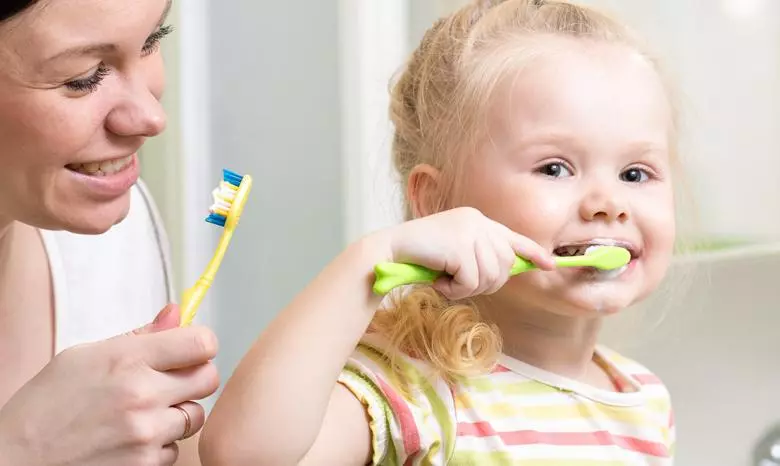Whatsapp: +90 (554) 160 5747 Online Appointment

Pediatric dentistry is the branch of dentistry that deals with the oral and dental health issues of children from birth until the end of adolescence, seeking solutions to these problems.
When Do Children’s Teeth Erupt?
The first tooth in babies usually starts to erupt around the 6th month. However, delays or early eruptions may sometimes occur.
Delayed tooth eruption is often associated with genetic predisposition; nevertheless, systemic disorders that may delay tooth eruption should not be overlooked.
Such disorders include thyroid, parathyroid, and growth hormone deficiencies that can hinder overall growth and development. Newborn babies have tooth buds at birth.
By the time of birth, all the buds (germs) of the primary (milk) teeth and the cusps of the first permanent molar (the six-year molar) are formed.
Teeth Erupting Between 4–8 Months:
If there is a slight swelling in the area of the upper incisors, this indicates that the upper right and left lateral incisors are erupting. The lower and upper central incisors have already erupted. The eruption sequence is: first upper central incisors, then upper lateral incisors, and later lower lateral incisors.
Teeth Erupting Between 8–11 Months:
All the upper and lower central and lateral incisors have erupted.
Teeth Erupting Between 11–15 Months:
All the upper and lower central and lateral incisors have erupted. The upper lateral primary incisors erupt about 12 months before the lower lateral primary incisors. Afterwards, the first primary molars begin to erupt.
Teeth Erupting Between 15–21 Months:
When the child is about 18 months old, the primary canines begin to erupt.
Teeth Erupting Between 1½–2½ Years:
The second primary molars in the upper and lower jaws have also erupted. The calcification of the roots of primary teeth completes one year after their crowns have erupted. The first permanent molar (six-year molar) erupts at around six years old. The six-year molar erupts behind the existing primary teeth. Children and parents often mistake the six-year molar for a primary tooth. Before it fully erupts, only its chewing surface may remain partially visible for months, creating spaces where food debris can accumulate and cause decay. Sometimes, gum inflammation occurs as well.
WHAT ARE THE SIGNS OBSERVED DURING TOOTH ERUPTION IN CHILDREN?
While primary teeth are erupting, some general and local changes can be observed in babies. These include loss of appetite, weight loss, diarrhea, irritability, increased salivation, itching, and redness in the gum area. There is no definitive treatment method to eliminate these symptoms. However, teething gels can be used to help the baby feed more comfortably and reduce pain. Additionally, certain syrups and teething toys can be used to relieve itching.
WHEN SHOULD CHILDREN FIRST VISIT A DENTIST?
Children should visit the dentist for a check-up when the first tooth erupts. Subsequently, dental check-ups should be repeated every six months for preventive measures.
WHAT PRECAUTIONS SHOULD BE TAKEN TO PREVENT TOOTH DECAY IN CHILDREN?
Children should be helped when brushing their teeth. They should brush their teeth twice a day, after breakfast and before bedtime. All necessary dental treatments for children’s oral care are performed by a dentist. To maintain excellent oral and dental health in children, they should have regular check-ups with a pediatric dentist every six months. During these visits, any issue that could threaten oral and dental health can be detected early. The key factor is detecting problems at an early stage and treating them promptly.
Fluoride Applications:
Fluoride therapy is one of the most effective preventive treatments in dentistry. It can be applied to healthy individuals, those prone to decay, for treating sensitivity and erosion, and to people with special care needs or systemic diseases. These applications are done at specific intervals and concentrations based on the person’s age and risk level for decay.
Fissure Sealants:
Naturally, the chewing surfaces of molars have pits and fissures where food particles can accumulate. Tooth decay often begins in areas that are difficult to clean. Fissure sealants act by shallowing these pits and fissures on the tooth’s surface, reducing food retention and creating a surface that is easier to brush. After this procedure, the incidence of tooth decay can decrease by 70–80%.
Endodontics is the branch of dentistry that deals with the treatment of root…
A healthy and beautiful smile gives you an advantage in many areas of life. It…
Teeth lose their whiteness over time due to the consumption of certain foods,…